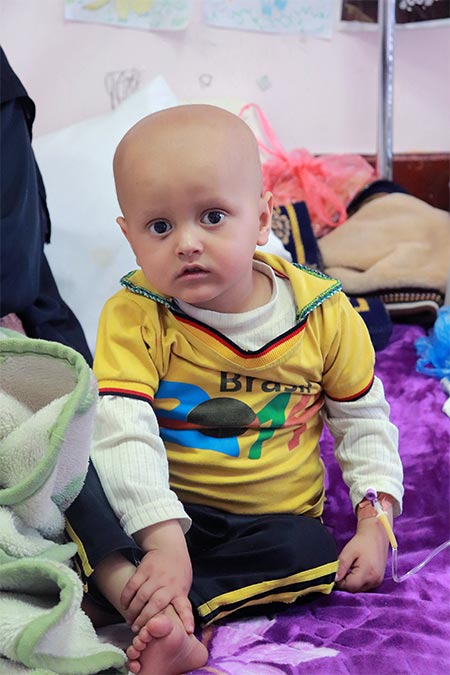“To travel for each treatment session, we pay almost 50 000 Yemeni Riyals for transport (less than US$ 100). This doesn’t even include the cost of accommodation, and we also have to borrow money to pay for each dose of anti-cancer medicines. My husband works as a teacher, but the government is not paying salaries any more. We have nothing,” says Mohammed’s mother.
Of the approximately 35 000 cancer patients in Yemen, Layan and Mohammed are just 2 of the more than 1000 children suffering from cancer, making up 12% of about 11 000 newly registered cancer cases in the country.
Cancer has become a death sentence
Cancer should not be a death sentence, but in Yemen it has become one. This is the case for many Yemenis who cannot afford the cost of treatment, and who stay at home and wait for death to relieve their pain.
It has been one-and-a-half years since Safia was diagnosed with a tumour in her oral cavity. Safia, who is originally from Hajjah, now lives in Haradh, a district hosting many displaced Yemenis from surrounding conflict-affected areas. Since her diagnosis, Safia has had more than 10 chemotherapy sessions and 33 radiation therapy sessions. Her son Abdulla said that travelling from Haradh to Sana’a for treatment weakens his mother, and has left the family bankrupt.
 Mohammed Ahmed, 3-and-a-half years old, suffers from kidney cancer“We have sold everything we own to afford treatment for my mother. Travelling from Haradh to Sana’a costs at least 120 000 YR (US$ 250). I lost my job at the beginning of the conflict and we now live on borrowed money and donations from charity organizations,” Abdulla explained.
Mohammed Ahmed, 3-and-a-half years old, suffers from kidney cancer“We have sold everything we own to afford treatment for my mother. Travelling from Haradh to Sana’a costs at least 120 000 YR (US$ 250). I lost my job at the beginning of the conflict and we now live on borrowed money and donations from charity organizations,” Abdulla explained.
Most cancer patients seek treatment at the National Oncology Centre in Sana’a that receives more than 600 patients per month. “Each day we receive at least 25 new cases. It is devastating to watch helpless patients leave the centre with little hope of coming back to continue treatment, simply because they cannot afford it,” said Dr Abdullah Thabaan, head of the communication unit.
“Even those patients who manage to travel to the centre for treatment are now at risk, as we are hugely underfunded and receive no operational costs. We are facing severe shortages of anti-cancer medicines, and the number of people receiving treatment may decrease if we are forced to turn people away.”
“The needs are immense and many patients will face imminent death if we close our doors,” Dr Thabaan added.
WHO's response
This year, WHO supported the National Oncology Centre in Sana’a with various life-saving anti-cancer medicines and chemotherapy medications. These medications are enough to cover acute shortages of medicines for 30 000 cancer patients for one year.
 Delivery of the mammography x-ray machine to Al Jumhoori hospital in Sana'a, that is used to detect breast cancerMoreover, WHO has delivered 2 mammography x-ray machines to Al Jumhoori hospital in Sana’a and Al Sadakah hospital in Aden. Mammography is a special X-ray machine for breast imaging, and is used to detect breast cancer early before women have any signs of disease. Mammograms can be also done for those women experiencing symptoms. Regular mammograms ensure early diagnosis of breast cancer and help achieve high rates of treatment and reduce the number of deaths from this type of cancer.
Delivery of the mammography x-ray machine to Al Jumhoori hospital in Sana'a, that is used to detect breast cancerMoreover, WHO has delivered 2 mammography x-ray machines to Al Jumhoori hospital in Sana’a and Al Sadakah hospital in Aden. Mammography is a special X-ray machine for breast imaging, and is used to detect breast cancer early before women have any signs of disease. Mammograms can be also done for those women experiencing symptoms. Regular mammograms ensure early diagnosis of breast cancer and help achieve high rates of treatment and reduce the number of deaths from this type of cancer.
“Noncommunicable diseases account for 57% of all deaths in Yemen. And cancer affects all age groups in the country, over 60% of whom are aged 30-69 years old — during the prime of these people’s lives. Cancer prevention is key, and WHO, UNICEF, along with local health authorities and partners are working to ensure that prevention is prioritized, allowing us to respond to this “hidden cost of war,” said Altaf Musani, WHO Representative in Yemen.
The delivery of these life-saving health supplies is a result of the generous support of the World Bank, USAID/OFDA, KSRelief, UAE Aid, ECHO, Canada, Korea, Japan, Germany and Kuwait.


